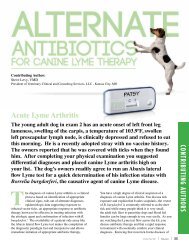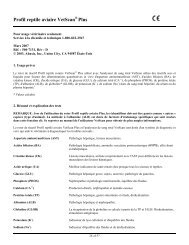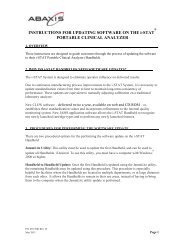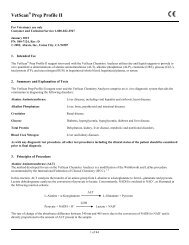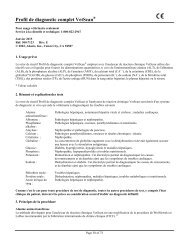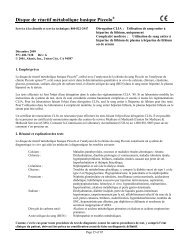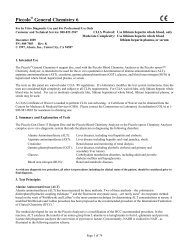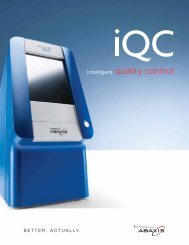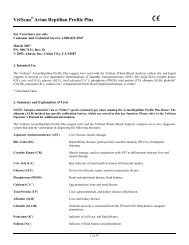VetScan® Kidney Profile Plus - Abaxis
VetScan® Kidney Profile Plus - Abaxis
VetScan® Kidney Profile Plus - Abaxis
You also want an ePaper? Increase the reach of your titles
YUMPU automatically turns print PDFs into web optimized ePapers that Google loves.
VetScan ® <strong>Kidney</strong> <strong>Profile</strong> <strong>Plus</strong><br />
For Veterinary use only<br />
Customer and Technical Service 1-800-822-2947<br />
January 2015<br />
PN: 500-7163-1, Rev. B<br />
© 2012, <strong>Abaxis</strong>, Inc., Union City, CA 94587<br />
1. Intended Use<br />
The VetScan ® <strong>Kidney</strong> <strong>Profile</strong> <strong>Plus</strong> reagent rotor used with the VetScan VS2 Chemistry Analyzer utilizes dry and liquid reagents to<br />
provide veterinary in vitro quantitative determination of albumin (ALB), calcium (CA ++ ), chloride (CL - ), creatinine (CRE),<br />
glucose (GLU), phosphorous (PHOS), potassium (K + ), sodium (NA + ), total carbon dioxide (tCO2), and urea nitrogen (BUN) in<br />
heparinized whole blood, heparinized plasma, or serum.<br />
2. Summary and Explanation of Tests<br />
The VetScan <strong>Kidney</strong> <strong>Profile</strong> <strong>Plus</strong> Reagent Rotor and the VetScan VS2 Chemistry Analyzer comprise an in vitro diagnostic system<br />
that aids the veterinarian in diagnosing the following disorders:<br />
Albumin<br />
Calcium<br />
Chloride<br />
Creatinine<br />
Glucose<br />
Phosphorus<br />
Potassium<br />
Sodium<br />
Total Carbon Dioxide<br />
Urea Nitrogen<br />
Liver and kidney diseases.<br />
Parathyroid, bone and chronic renal disease; tetany.<br />
Chronic diarrhea, chronic vomiting, renal disease, parathyroid disease, chronic respiratory<br />
acidosis or alkalosis, hyperadrenocorticism, hypoadrenocorticism, and thiazide therapy.<br />
Renal disease.<br />
Diabetes, hyperglycemia, hypoglycemia and liver disease.<br />
<strong>Kidney</strong> disease, hypoparathyroidism and nutritional disorders.<br />
Malnutrition and renal disease. This electrolyte is used to diagnose the causes of vomiting,<br />
diarrhea and cardiac symptoms.<br />
Dehydration, and diabetes. This electrolyte is used to diagnose the causes of vomiting, diarrhea<br />
and cardiac symptoms.<br />
Primary metabolic alkalosis and acidosis, and primary respiratory alkalosis and acidosis.<br />
Liver and kidney diseases.<br />
As with any diagnostic test procedure, all other test procedures including the clinical status of the patient, should be<br />
considered prior to final diagnosis.<br />
3. Principle of Procedure<br />
Albumin<br />
Dye binding techniques are the most frequently used methods for measuring albumin. Bromcresol green (BCG) is the most<br />
commonly used of the dye binding methods. 1<br />
Page 1 of 12
BCG + Albumin<br />
Surfactants<br />
Acid pH<br />
BCG-Albumin Complex<br />
Bound albumin is proportional to the concentration of albumin in the sample. This is an endpoint reaction that is measured<br />
bichromatically at 630 nm and 405 nm.<br />
Total Calcium<br />
The reference method for calcium is atomic absorption spectroscopy; however, this method is not suited for routine use. 2<br />
Spectrophotometric methods using either o-cresolphthalein complexone (CPC) or arsenazo III metallochromic indicators are most<br />
commonly used. 3,4,5 Arsenazo III has a high affinity for calcium and is not as temperature dependent as CPC.<br />
Calcium in the patient sample binds with arsenazo III to form a calcium-dye complex.<br />
Ca 2+ + Arsenazo III<br />
Ca 2+ -Arsenazo III Complex<br />
The endpoint reaction is monitored at 405 nm, 467 nm and 600 nm. The amount of calcium in the sample is proportional to the<br />
absorbance.<br />
Chloride (Cl - )<br />
The method is based on the determination of chloride-dependent activation of α-amylase activity. Deactivated α-amylase is<br />
reactivated by addition of the chloride ion, allowing the calcium to re-associate with the enzyme. The reactivation of α-amylase<br />
activity is proportional to the concentration of chloride ions in the sample. The reactivated α-amylase converts the substrate, 2-<br />
chloro-p-nitrophenyl-α-D-maltotrioside (CNPG3) to 2-chloro-p-nitrophenol (CNP) producing color and α-maltotriose (G3). The<br />
reaction is measured bichromatically and the increase in absorbance is directly proportional to the reactivated α-amylase activity<br />
and the concentration of chloride ion in the sample. 6<br />
CNPG3<br />
-Amylase<br />
Cl - , Ca 2+<br />
CNP + G3<br />
Creatinine (CRE)<br />
The Jaffe method, first introduced in 1886, is still a commonly used method of determining creatinine levels in blood. The current<br />
reference method combines the use of Fuller’s earth (floridin) with the Jaffe technique to increase the specificity of the reaction. 7, 8<br />
Enzymatic methods have been developed that are more specific for creatinine than the various modifications of the Jaffe<br />
technique. 9, 10, 11 Methods using the enzyme creatinine amidohydrolase eliminate the problem of ammonium ion interference found<br />
in techniques using creatinine iminohydrolase. 12<br />
Creatinine + H 2 O<br />
Creatine + H 2 O<br />
Creatinine Amidohydrolase<br />
Creatine Amidinohydrolase<br />
Creatine<br />
Sarcosine + Urea<br />
Sarcosine Oxidase<br />
Sarcosine + H 2 O + O 2 Glycine + Formaldehyde + H 2 O 2<br />
H 2 O 2 + TBHBA + 4-AAP<br />
Peroxidase<br />
Red Quinoneimine Dye + H 2 O<br />
Two cuvettes are used to determine the concentration of creatinine in the sample. Endogenous creatine is measured in the blank<br />
cuvette, which is subtracted from the combined endogenous creatine and the creatine formed from the enzyme reactions in the test<br />
cuvette. Once the endogenous creatine is eliminated from the calculations, the concentration of creatinine is proportional to the<br />
intensity of the red color produced. The endpoint reaction is measured as the difference in absorbance between 550 nm and<br />
600 nm.<br />
Glucose (GLU)<br />
Measurements of glucose concentration were first performed using copper-reduction methods (such as Folin-Wu 13 and Somogyi-<br />
Nelson 14, 15 ). The lack of specificity in copper-reduction techniques led to the development of quantitative procedures using the<br />
Page 2 of 12
enzymes hexokinase and glucose oxidase. The <strong>Abaxis</strong> glucose is a modified version of the hexokinase method, which has been<br />
proposed as the basis of the glucose reference method. 16<br />
The reaction of glucose with adenosine triphosphate (ATP), catalyzed by hexokinase (HK), produces glucose-6-phosphate (G-6-P)<br />
and adenosine diphosphate (ADP). Glucose-6-phosphate dehydrogenase (G-6-PDH) catalyzes the reaction of G-6-P into<br />
6-phosphogluconate and the reduction of nicotinamide adenine dinucleotide (NAD + ) to NADH.<br />
Glucose + ATP<br />
HK<br />
Mg 2+<br />
G-6-P + ADP<br />
G-6-PDH<br />
G-6-P + NAD + 6-Phosphogluconate + NADH + H +<br />
Phosphorus<br />
The <strong>Abaxis</strong> phosphorus method uses sucrose phosphorylase (SP) coupled with the phosphoglucomutase (PGM) and<br />
glucose-6-phosphate dehydrogenase (G-6-PDH) reactions. 17,18 Using the enzymatic system, for each mole of inorganic phosphorus<br />
present in the sample, one mole of NADH is formed. The amount of NADH formed is measured as an endpoint at 340 nm.<br />
Sucrose + P i<br />
SP<br />
Glucose-1-Phoshpate (G-1-P) + Fructose<br />
G-1-P<br />
PGM, Mg 2+<br />
Glucose-6-Phosphate<br />
Glucose-6-Phosphate + NAD +<br />
G-6-PDH<br />
NADH + 6-Phosphogluconate + H +<br />
Potassium (K + )<br />
Spectrophotometric methods have been developed that allow the measurement of potassium concentration on standard clinical<br />
chemistry instrumentation. The <strong>Abaxis</strong> enzymatic method is based on the activation of pyruvate kinase with potassium shows<br />
excellent linearity and negligible susceptibility to endogenous substances. 19, 20, 21 Interference from sodium and ammonium ion are<br />
minimized with the addition of Kryptofix and glutamate dehydrogenase respectively. 19<br />
In the coupled-enzyme reaction, pyruvate kinase (PK) dephoshorylates phosphoenolpyruvate (PEP) to form pyruvate. Lactate<br />
dehydrogenase (LDH) catalyzes conversion of pyruvate to lactate. Concomitantly, NADH is oxidized to NAD + . The rate of<br />
change in absorbance between 340 nm and 405 nm is due to the conversion of NADH to NAD + , which is directly proportional to<br />
the amount of potassium in the sample.<br />
ADP + PEP<br />
K + , PK<br />
Pyruvate + ATP<br />
LDH<br />
Pyruvate + NADH + H + Lactate + NAD +<br />
Sodium (Na + )<br />
Colorimetric and enzymatic methods have been developed that allow the measurement of sodium concentration on standard<br />
clinical chemistry instrumentation. 22, 23, 24 In the <strong>Abaxis</strong> enzymatic reaction, -galactosidase is activated by the sodium in the<br />
sample. The activated enzyme catalyzes the reaction of -nitrophenyl--D-galactopyranoside (ONPG) to -nitrophenol and<br />
galactose. The reaction rate between 405 nm and 500 nm is proportional to sodium concentration.<br />
Na +<br />
ONPG + H 2 O<br />
-Galactosidase<br />
-Nitrophenol + Galactose<br />
Page 3 of 12
Total Carbon Dioxide (tCO 2 )<br />
Total carbon dioxide in serum or plasma exists as dissolved carbon dioxide, carbamino derivatives of proteins, bicarbonate and<br />
carbonate ions and carbonic acid. Total carbon dioxide can be measured by pH indicator, CO 2 electrode and spectrophotometric<br />
enzymatic methods, which all produce accurate and precise results. 25, 26 The enzymatic method is well suited for use on a routine<br />
blood chemistry analyzer without adding complexity.<br />
In the enzymatic method, the specimen is first made alkaline to convert all forms of carbon dioxide (CO 2 ) toward bicarbonate<br />
(HCO - -<br />
3 ). Phosphoenolpyruvate (PEP) and HCO 3 then react to form oxaloacetate and phosphate in the presence of<br />
phosphoenolpyruvate carboxylase (PEPC). Malate dehydrogenase (MDH) catalyzes the reaction of oxaloacetate and reduced<br />
nicotinamide adenine dinucleotide (NADH) to NAD + and malate. The rate of change in absorbance due to the conversion of<br />
NADH to NAD + is directly proportional to the amount of tCO 2 in the sample.<br />
PEP + HCO 3<br />
PEPC<br />
Oxaloacetate + Phosphate<br />
Oxaloacetate + NADH + H +<br />
MDH<br />
NAD + + Malate<br />
Urea Nitrogen (BUN)<br />
A coupled-enzymatic reaction is used by the <strong>Abaxis</strong> system. In this reaction, urease hydrolyzes urea into ammonia and carbon<br />
dioxide. 27 Upon combining ammonia with 2-oxoglutarate and reduced nicotinamide adenine dinucleotide (NADH), the enzyme<br />
glutamate dehydrogenase (GLDH) oxidizes NADH to NAD + .<br />
Urease<br />
Urea + H 2 O 2NH 3 + CO 2<br />
GLDH<br />
NH 3 + NADH + H + + 2-Oxoglutarate L-Glutamate + H 2 O + NAD +<br />
The rate of change of the absorbance difference between 340 nm and 405 nm is caused by the conversion of NADH to NAD + and<br />
is directly proportional to the amount of urea present in the sample.<br />
4. Principle of Operation<br />
See the VetScan VS2 Chemistry Analyzer Operator’s Manual, for the Principles and Limitations of the Procedure.<br />
5. Description of Reagents<br />
Reagents<br />
Each VetScan <strong>Kidney</strong> <strong>Profile</strong> <strong>Plus</strong> Reagent Rotor contains dry test-specific reagent beads (described below). A dry sample blank<br />
reagent (comprised of buffer, surfactants, excipients, and preservatives) is included in each reagent rotor for use in calculating<br />
concentrations of albumin (ALB), calcium (CA ++ ), chloride (CL - ), glucose (GLU), phosphorus (PHOS), potassium (K + ), sodium<br />
(NA + ), total carbon dioxide (tCO2), and urea nitrogen (BUN). Dedicated sample blanks are included in the rotor to calculate the<br />
concentration of creatinine (CRE). Each reagent rotor also contains a diluent consisting of surfactants and preservatives.<br />
Warnings and Precautions<br />
<br />
<br />
<br />
<br />
For Veterinary In vitro Diagnostic Use<br />
The diluent container in the reagent rotor is automatically opened when the analyzer drawer closes. A rotor with an opened<br />
diluent container cannot be re-used. Ensure that the sample or control has been placed into the rotor before closing the drawer.<br />
Reagent beads may contain acids or caustic substances. The operator does not come into contact with the reagent beads when<br />
following the recommended procedures. In the event that the beads are handled (e.g., cleaning up after dropping and cracking<br />
a reagent rotor), avoid ingestion, skin contact, or inhalation of the reagent beads.<br />
Some Reagent beads contain sodium azide, which may react with lead and copper plumbing to form highly explosive metal<br />
azides. Reagents will not come into contact with lead and copper plumbing when following recommended procedures.<br />
Page 4 of 12
However, if the reagents do come into contact with such plumbing, flush with a large volume of water to prevent azide<br />
buildup.<br />
Instructions for Reagent Handling<br />
Reagent rotors may be used directly from the refrigerator without warming. Open the sealed foil pouch and remove the rotor being<br />
careful not to touch the bar code ring located on the top of the reagent rotor. Use according to the instructions provided in the<br />
VetScan VS2 Operator’s Manual. A rotor not used within 20 minutes of opening the pouch should be discarded. Rotors in opened<br />
pouches can not be placed back in the refrigerator for use at a later time.<br />
Storage<br />
Store reagent rotors in their sealed pouches at 2-8˚C (36-46˚F). Do not expose opened or unopened rotors to direct sunlight or<br />
temperatures above 32˚C (90˚F). Do not allow the rotors sealed in their foil pouches to remain at room temperature longer than 48<br />
hours prior to use. Open the pouch and remove the rotor just prior to use.<br />
Indications of Reagent Rotor Instability/Deterioration.<br />
All reagents contained in the reagent rotor, when stored as described above, are stable until the expiration date printed on the<br />
rotor pouch. Do not use a rotor after the expiration date. The expiration date is also encoded in the bar code printed on the<br />
bar code ring. An error message will appear on the VetScan VS2 Chemistry Analyzer display if the reagents have expired.<br />
<br />
A torn or otherwise damaged pouch may allow moisture to reach the unused rotor and adversely affect reagent performance.<br />
Do not use a rotor from a damaged pouch.<br />
6. Instrument<br />
See the VetScan VS2 Chemistry Analyzer Operator’s Manual for complete information on use of the analyzer.<br />
7. Sample Collection and Preparation<br />
The minimum required sample size is ~100 µL of heparinized whole blood, heparinized plasma, serum or control. The reagent<br />
rotor sample chamber can contain up to 120 µL of sample.<br />
<br />
<br />
<br />
<br />
<br />
Specimens collected in a heparinized micropipette should be dispensed into the reagent rotor immediately following sample<br />
collection.<br />
Use only lithium heparin (green stopper) evacuated specimen collection tubes for whole blood or plasma samples. Use<br />
no-additive (red stopper) evacuated specimen collection tubes or serum separator tubes (red or red/black stopper) for serum<br />
samples.<br />
Whole blood samples obtained by venipuncture must be homogeneous before transferring a sample to the reagent rotor.<br />
Gently invert the collection tube several times just prior to sample transfer. Do not shake the collection tube; shaking may<br />
cause hemolysis.<br />
The test must be started within 10 minutes of transferring the sample into the reagent rotor.<br />
Whole blood venipuncture samples should be run within 60 minutes of collection; if this is not possible, separate the sample<br />
and transfer it into a clean test tube. 28 Run the separated plasma or serum sample within 5 hours of centrifugation. If this is not<br />
possible, refrigerate the sample in a stoppered test tube at 2-8°C (36-46°F) for no longer than 48 hours.<br />
A plasma or serum sample can be stored at -10°C (14°F) for up to 5 weeks in a freezer that does not have a self-defrost cycle.<br />
Glucose concentration decreases approximately 5-12 mg/dL in 1 hour in uncentrifuged samples stored at room temperature. 29<br />
Refrigerating whole blood samples can cause significant changes in concentrations of creatinine and glucose. 30<br />
<br />
<br />
Samples with amylase concentrations >4000 U/L will give falsely high chloride readings.<br />
The concentration of total carbon dioxide is most accurately determined when the assay is done immediately after opening the<br />
tube and as promptly as possible after collection and processing of the blood in the unopened tube. Ambient air contains far<br />
less carbon dioxide than does plasma, and gaseous dissolved carbon dioxide will escape from the specimen into the air, with a<br />
consequent decrease in carbon dioxide value of up to 6 mmol/L in the course of 1 hour. 31<br />
Page 5 of 12
Known Interfering Substances<br />
The only anticoagulant recommended for use with the VetScan VS2 Chemistry Analyzer is lithium heparin. Sodium heparin<br />
must not be used when collecting blood samples for use with this panel. <strong>Abaxis</strong> has performed studies demonstrating that<br />
EDTA, fluoride, oxalate, and any anticoagulant containing ammonium ions will interfere with at least one chemistry in the<br />
VetScan <strong>Kidney</strong> <strong>Profile</strong> <strong>Plus</strong> reagent rotor.<br />
<br />
<br />
<br />
<br />
Physical interferents (hemolysis, icterus, and lipemia) may cause changes in the reported concentrations of some analytes. The<br />
sample indices are printed on the bottom of each result card to inform the operator about the levels of interferents present in<br />
each sample. The VetScan VS2 Chemistry Analyzer suppresses any results that are affected by >10% interference from<br />
hemolysis, lipemia, or icterus. “HEM”, “LIP”, “ICT” is printed on the result card in place of the result.<br />
Hemolysis may cause erroneously high results in potassium assays. This problem may go undetected when analyzing whole<br />
blood (release of potassium from as few as 0.5% of the erythrocytes can increase the potassium serum level by 0.5 mmol/L).<br />
In particular, even unhemolyzed specimens that are not promptly processed may have increased potassium levels due to<br />
intracellular potassium leakage. 32<br />
Glucose concentrations are affected by the length of time since the patient has eaten and by the type of sample collected from<br />
the patient. To accurately interpret glucose results, samples should be obtained from a patient that has been fasted for at least<br />
12 hours. 33<br />
The potassium assay in the VetScan VS2 system is a coupled pyruvate kinase (PK) / lactate dehydrogenase (LDH) assay.<br />
Therefore, in cases of extreme muscle trauma or highly elevated levels of creatine kinase (CK), the VetScan may recover a<br />
falsely elevated potassium (K+) value. In such cases, unexpected high potassium recoveries need to be confirmed utilizing a<br />
different methodology<br />
8. Procedure<br />
Materials Provided<br />
One VetScan <strong>Kidney</strong> <strong>Profile</strong> <strong>Plus</strong> Reagent Rotor<br />
Materials Required but not Provided<br />
VetScan VS2 Chemistry Analyzer<br />
Test Parameters<br />
The VetScan VS2 Chemistry Analyzer operates at ambient temperatures between 15°C and 32°C (59-90°F). The analysis time for<br />
each VetScan <strong>Kidney</strong> <strong>Profile</strong> <strong>Plus</strong> Reagent Rotor is less than 14 minutes. The analyzer maintains the reagent rotor at a temperature<br />
of 37°C (98.6°F) over the measurement interval.<br />
Test Procedure<br />
The complete sample collection and step-by-step operating procedures are detailed in the VetScan VS2 Chemistry Analyzer<br />
Operator’s Manual.<br />
Calibration<br />
The VetScan VS2 Chemistry Analyzer is calibrated by the manufacturer before shipment. The barcode printed on the barcode ring<br />
provides the analyzer with rotor-specific calibration data. Please see the VetScan VS2 Chemistry Analyzer Operator’s Manual.<br />
Quality Control<br />
Controls may be run periodically on the VetScan VS2 Chemistry Analyzer to verify the accuracy of the analyzer. <strong>Abaxis</strong><br />
recommends that a serum-based commercially available control be run. Run controls on the reagent rotor in the same manner as<br />
for patient samples. See the VetScan VS2 Operator’s Manual to run controls.<br />
9. Results<br />
The VetScan VS2 Chemistry Analyzer automatically calculates and prints the analyte concentrations in the sample. Details of the<br />
endpoint and rate reaction calculations are found in the VetScan VS2 Chemistry Analyzer Operator’s Manual.<br />
10. Limitations of Procedure<br />
General procedural limitations are discussed in the VetScan VS2 Chemistry Analyzer Operator’s Manual.<br />
Page 6 of 12
If a result for a particular test exceeds the assay range, the sample should be analyzed by another approved test<br />
method or sent to a referral laboratory.<br />
Samples with hematocrits in excess of 60% packed red cell volume may give inaccurate results. Samples with high<br />
hematocrits may be reported as hemolyzed. These samples may be spun down to get plasma then re-run in a new reagent<br />
rotor.<br />
Warning:<br />
Extensive testing of the VetScan VS2 Chemistry System has shown that in very rare instances, sample<br />
dispensed into the reagent rotor may not flow smoothly into the sample chamber. Due to the uneven flow, an<br />
inadequate quantity of sample may be analyzed and several results may fall outside the reference ranges. The<br />
sample may be re-run using a new reagent rotor.<br />
11. Expected Values<br />
These normal intervals are provided only as a guideline. The most definitive reference intervals are those established for your<br />
patient population. Test results should be interpreted in conjunction with the patient’s clinical signs. To customize specific normal<br />
ranges in your VetScan VS2 Chemistry Analyzer for the “Other” bank, refer to your VetScan VS2 Operator’s Manual under the<br />
Menu Key functions.<br />
Table 1: VetScan Reference Intervals<br />
Analyte Canine Feline Equine<br />
Albumin (ALB)<br />
2.5 – 4.4 g/dL<br />
(25–44 g/L)<br />
2.2 – 4.4 g/dL<br />
(22–44 g/L)<br />
2.2 – 3.7 g/dL<br />
(22–37 g/L)<br />
Calcium (CA++)<br />
8.6 – 11.8 mg/dL<br />
(2.2–3.0 mmol/L)<br />
8.0 – 11.8 mg/dL<br />
(2.0–3.0 mmol/L)<br />
11.5 – 14.2 mg/dL<br />
(2.9–3.6 mmol/L)<br />
Chloride (CL - ) 106 – 120 mmol /L 112 – 126 mmol /L* 92 – 104 mmol /L<br />
Creatinine (CRE)<br />
0.3 – 1.4 mg/dL<br />
(27–124 µmol/L)<br />
0.3 – 2.1 mg/dL<br />
(27–186 µmol/L)<br />
0.6 - 2.2 mg/dL<br />
(53-194 µmol/L)<br />
Glucose (GLU)<br />
60 – 110 mg/dL<br />
(3.3–6.1 mmol/L)<br />
70 – 150 mg/dL<br />
(3.9–8.3 mmol/L)<br />
65 – 110 mg/dL<br />
(3.6–6.1 mmol/L)<br />
Phosphorous (PHOS)<br />
2.9 – 6.6 mg/dL<br />
(0.94–2.13 mmol/L)<br />
3.4 – 8.5 mg/dL<br />
(1.10–2.74 mmol/L)<br />
1.9 – 4.3 mg/dL<br />
(0.61–1.39 mmol/L)<br />
Potassium (K + ) 3.7 – 5.8 mmol/L 3.7 – 5.8 mmol/L 2.5 – 5.2 mmol/L<br />
Sodium (Na + ) 138 – 160 mmol/L 142 – 164 mmol/L 126 – 146 mmol/L<br />
Total Carbon Dioxide (tCO 2 ) 12 – 27 mmol/L 15 – 24 mmol/L 20 – 33 mmol/L<br />
Urea Nitrogen (BUN)<br />
7 – 25 mg/dL<br />
(2.0–9.0 mmol/urea/L)<br />
10 – 30 mg/dL<br />
(4.0–11.0 mmol/urea/L)<br />
7 – 25 mg/dL<br />
(2.0–9.0 mmol/urea/L)<br />
*Feline reference interval is for adult cats only; kittens (cats younger than 6 months) may have lower chloride levels.<br />
12. Performance Characteristics (Linearity)<br />
The chemistry for each analyte is linear over the dynamic range listed below when the VetScan VS2 System is operated according<br />
to the recommended procedure (see the VetScan VS2 Operator’s Manual). The Dynamic Range table referenced below represents<br />
the spectrum that the VetScan VS2 System can detect. The intervals below do not represent normal ranges.<br />
Table 2: VetScan Dynamic Ranges<br />
Analyte Common Units SI Units<br />
Albumin 1 – 6.5 g/dL 10 – 65 g/L<br />
Calcium 4 – 16 mg/dL 1.0 – 4.0 mmol/L<br />
Chloride 80 – 135 mmol/L 80 – 135 mmol/L<br />
Glucose 10 – 700 mg/dL 0.56 – 38.9 mmol/L<br />
Creatinine 0.2 – 20 mg/dL 18 – 1768 µmol/L<br />
Page 7 of 12
Table 2: VetScan Dynamic Ranges (continued)<br />
Phosphorous 0 – 20 mg/dL 0 – 6.46 mmol/L<br />
Potassium 1.5 – 8.5 mmol/L 1.5 – 8.5 mmol/L<br />
Sodium 110 – 170 mmol/L 110 – 170 mmol/L<br />
Total Carbon Dioxide 5 – 40 mmol/L 5 – 40 mmol/L<br />
Urea Nitrogen 2 – 180 mg/dL 0.7 – 64.3 mmol/urea/L<br />
Precision<br />
Precision studies were conducted using NCCLS (CLSI) EP5-A and CLSI EP5-A2 guidelines 34, 35 with modifications based on<br />
NCCLS (CLSI) EP18-P and CLSI EP18-A2 36, 37 for unit-use devices. Results for within-run and total precision were determined<br />
by testing bi-level controls.<br />
Table 3: Precision<br />
Analyte Sample Size Within-Run Total<br />
Albumin-BCG (g/dL) n=80<br />
Control 1<br />
Mean 3.9 3.9<br />
SD 0.13 0.14<br />
%CV 3.3 3.6<br />
Control 2<br />
Mean 2.3 2.3<br />
SD 0.09 0.10<br />
%CV 3.9 4.3<br />
Calcium (mg/dL) n=80<br />
Control 1<br />
Mean 8.6 8.6<br />
SD 0.21 0.25<br />
%CV 2.4 2.9<br />
Control 2<br />
Mean 11.8 11.8<br />
SD 0.39 0.40<br />
%CV 3.3 3.4<br />
Chloride (mmol/L)<br />
Control 1 N = 160<br />
Mean 97.8 97.8<br />
SD 1.63 1.74<br />
%CV 1.7 1.7<br />
Control 2<br />
Mean 113.6 113.6<br />
SD 1.97 2.22<br />
%CV 1.7 2.0<br />
Creatinine (mg/dL)<br />
Control 1 N=80<br />
Mean 1.1 1.1<br />
SD 0.14 0.14<br />
%CV 12.7 12.7<br />
Control 2<br />
Mean 5.2 5.2<br />
SD 0.23 0.27<br />
%CV 4.4 5.2<br />
Page 8 of 12
Table 3: Precision (continued)<br />
Analyte Sample Size Within-Run Total<br />
Glucose (mg/dL)<br />
Control 1 N=80<br />
Mean 66 66<br />
SD 0.76 1.03<br />
%CV 1.2 1.6<br />
Control 2<br />
Mean 278 278<br />
SD 2.47 3.84<br />
%CV 0.9 1.4<br />
Phosphorus (mg/dL) n=80<br />
Control 1<br />
Mean 6.9 6.9<br />
SD 0.2 0.2<br />
%CV 2.2 2.6<br />
Control 2<br />
Mean 3.4 3.4<br />
SD 0.1 0.2<br />
%CV 4.1 4.9<br />
Potassium (mmol/L)<br />
Control 1 N = 80<br />
Mean 6.7 6.7<br />
SD 0.26 0.26<br />
%CV 3.9 3.9<br />
Control 2<br />
Mean 4.3 4.3<br />
SD 0.22 0.22<br />
%CV 5.1 5.1<br />
Sodium (mmol/L)<br />
Control 1 N = 80<br />
Mean 148 148<br />
SD 5.1 5.1<br />
%CV 3.4 3.4<br />
Control 2<br />
Mean 118 118<br />
SD 3.2 3.2<br />
%CV 2.7 2.7<br />
Total Carbon Dioxide (mmol/L)<br />
Control 1 N = 80<br />
Mean 19 19<br />
SD 1.39 1.39<br />
%CV 7.3 7.3<br />
Control 2<br />
Mean 9 9<br />
SD 0.60 0.60<br />
%CV 6.8 6.8<br />
Urea Nitrogen (mg/dL)<br />
Control 1 N = 80<br />
Mean 19 19<br />
SD 0.35 0.40<br />
%CV 1.8 2.1<br />
Page 9 of 12
Table 3: Precision (continued)<br />
Analyte Sample Size Within-Run Total<br />
Urea Nitrogen (mg/dL)<br />
Control 2<br />
Mean 65 65<br />
SD 1.06 1.18<br />
%CV 1.6 1.8<br />
Correlation<br />
Field studies were conducted at a veterinary teaching hospital. Serum samples were analyzed by the VetScan VS2 Chemistry<br />
Analyzer and a comparative method. Representative correlation statistics are shown in Table 4.<br />
Table 4: Correlation of the VetScan VS2 Chemistry Analyzer with Comparative Method(s)<br />
Albumin (g/dL)<br />
Calcium (mg/dL)<br />
Chloride (mmol/L)<br />
Creatinine (mg/dL)<br />
Glucose (mg/dL)<br />
Phosphorous<br />
(mg/dL)<br />
Potassium (mmol/L)<br />
Sodium (mmol/L)<br />
Total Carbon<br />
Dioxide (mmol/L)<br />
Urea Nitrogen<br />
(mg/dL)<br />
Canine<br />
Feline<br />
Equine<br />
Canine<br />
Feline<br />
Equine<br />
Canine<br />
Feline<br />
Equine<br />
Canine<br />
Feline<br />
Equine<br />
Canine<br />
Feline<br />
Equine<br />
Canine<br />
Feline<br />
Equine<br />
Canine<br />
Feline<br />
Equine<br />
Canine<br />
Feline<br />
Equine<br />
Canine<br />
Feline<br />
Equine<br />
Canine<br />
Feline<br />
Equine<br />
Correlation<br />
Coefficient<br />
0.96<br />
0.75<br />
0.89<br />
0.84<br />
0.77<br />
0.94<br />
0.935<br />
0.979<br />
NA<br />
0.99<br />
1.00<br />
0.95<br />
0.96<br />
1.00<br />
0.97<br />
0.994<br />
0.916<br />
0.971<br />
0.96<br />
0.91<br />
0.84<br />
0.89<br />
0.86<br />
0.86<br />
0.81<br />
0.93<br />
0.97<br />
1.00<br />
1.00<br />
1.00<br />
Slope Intercept N<br />
0.99<br />
1.02<br />
0.99<br />
1.24<br />
1.24<br />
1.18<br />
0.875<br />
0.882<br />
NA<br />
1.00<br />
1.01<br />
1.00<br />
1.01<br />
0.97<br />
0.94<br />
1.09<br />
0.80<br />
0.991<br />
0.92<br />
0.92<br />
0.97<br />
0.97<br />
1.08<br />
1.00<br />
0.86<br />
0.90<br />
0.93<br />
0.98<br />
1.07<br />
0.95<br />
0.1<br />
0<br />
-0.6<br />
-1.9<br />
-2.1<br />
-0.8<br />
15<br />
12<br />
NA<br />
0.0<br />
-0.1<br />
-0.4<br />
-6<br />
3<br />
16<br />
-0.19<br />
0.81<br />
-0.06<br />
0.4<br />
0.5<br />
0.1<br />
4.8<br />
-12.2<br />
-0.01<br />
3.5<br />
2.4<br />
2.1<br />
-2<br />
-5<br />
-1<br />
22-180<br />
21-55<br />
7-101<br />
22-180<br />
21-55<br />
7-101<br />
38<br />
20<br />
NA<br />
22 – 180<br />
21 – 55<br />
7 – 101<br />
22 – 180<br />
21 – 55<br />
7 – 101<br />
22-180<br />
21-55<br />
7-101<br />
22 – 180<br />
21 – 55<br />
7 – 101<br />
22 – 180<br />
21 – 55<br />
7 – 101<br />
22 – 180<br />
21 – 55<br />
7 – 101<br />
22 – 180<br />
21 – 55<br />
7 – 101<br />
Sample<br />
Range<br />
1.3-4.6<br />
2.1-4.8<br />
1.2-3.2<br />
7.3-13.0<br />
6.3-12.4<br />
7.2-15.1<br />
78 – 132<br />
86 – 123<br />
NA<br />
0.6 – 10.6<br />
0.3 – 13.6<br />
0.3 – 6.2<br />
28 – 348<br />
52 – 607<br />
36 – 353<br />
0.8-87<br />
2.4-6.9<br />
0.8-7.8<br />
3.2 – 6.9<br />
2.7 – 5.3<br />
1.8 – 4.6<br />
118 – 183<br />
122 – 166<br />
110 – 166<br />
6 – 23<br />
7 – 31<br />
9 – 39<br />
4 – 117<br />
14 – 165<br />
3 – 64<br />
Page 10 of 12
13. Bibliography<br />
1. Webster D, et al. An assessment on the suitability of bromocresol green for the determination of serum albumin. Clin Chim<br />
Acta 1974;53:101-8.<br />
2. Cali JP, Bowers GN, Young DS, et al. A reference method for the determination of total calcium in serum. In: GR Cooper,<br />
ed., Selected methods of Clinical Chemistry. Washington, DC: American Association for Clinical Chemistry; 1977;8:3-8.<br />
3. Kessler G, M Wolfman. An Automated procedure for the simultaneous determination of calcium and phosphorus.<br />
Clin Chem 1964;10: 686-703.<br />
4. Michaylova V, P Ilkova. Photometric determination of micro amounts of calcium with arsenazo III. Anal Chim Acta 1971;53:<br />
194-8.<br />
5. Scarpa A, et al. Metallochromic indicators of ionized calcium. Ann NY Acad Sci 1978;307:86-112.<br />
6. Ono T, et al. A new enzymatic assay of chloride in serum. Clin Chem 1988; 34: 552-553.<br />
7. Knoll VE, et al. Spezifische kreatininbetimmung im serum. Z Klin Chemi Clin Biochem. 1970; 8: 582-587.<br />
8. Haeckel R, et al. Simplified determinations of the “true” creatinine concentration in serum and urine. J Cklin Chem Clin<br />
Biochem. 1980; 18: 385-394.<br />
9. Moss GA, et al. Kinetic enzymatic method for determining serum creatinine. Clin Chem 1975; 21: 1422-1426.<br />
10. Jaynes PK, et al. An enzymatic, reaction-rate assay for serum creatinine with a centrifugal analyzer. Clin Chem 1982; 28: 114-<br />
117.<br />
11. Fossati P, et al. Enzymatic creatinine assay: a new colorimetric method based on hydrogen peroxide measurement. Clin Chem<br />
1983; 29: 1494-1496.<br />
12. Whelton A, et al. Nitrogen Metabolites and Renal Function. In:CA Burtis and ER Ashwood, Eds., Tietz Textbook of Clinical<br />
Chemistry, 3 rd Ed. Philadelphia: W.B. Saunders Company. 1999;1513-1575.<br />
13. Folin O, and Wu H. A system of blood analysis. J Biol Chem. 1919; 38: 81-110.<br />
14. Somogyi M. A reagent for the copper-iodometric determination of very small amounts of sugar. J Biol Chem. 1937; 117: 771-<br />
776.<br />
15. Nelson N. A photometric adaption of the Somogyi method for the determination of glucose. J Biol. 1944; 153: 375-380.<br />
16. Kaplan LA. Glucose. In:LA Kaplan and AJ Pesce, eds., Clinical Chemistry: Theory, Analysis, and Correlation,<br />
2 nd ed St. Louis: The C.V. Mosby Company; 1989;850-856.<br />
17. Schulz DW, et al. An Enzymic Method for the Measurement of Inorganic Phosphate Determination Anal Biochem<br />
1967;19:300-14.<br />
18. Tedokon, M Suzuki, et al. Enzymatic Assay of Inorganic Phosphate with Use of Sucrose Phosphorylase and<br />
Phosphoglucomutase. Clin Chem 1992;38:512-5.<br />
19. Berry MN, et al. Enzymatic determination of potassium in serum. Clin Chem 1989; 35: 817-20.<br />
20. Van Pelt J. Enzymatic determination of sodium, potassium and chloride in serum compared with determination by flame<br />
photometry, coulometry and ion selective electrodes. Clin Chem 1994; 40: 846-847.<br />
21. Hubl W, et al. Enzymatic determination of sodium, potassium and chloride in abnormal (hemolyzed, icteric, lipemic,<br />
paraproteinemic, or uremic) serum samples compared with indirect determination with ion selective electrodes. Clin Chem<br />
1994; 40: 1528-31.<br />
22. Helgerson RC, et al. Host-guest Complexation. 50. Potassium and sodium ion-selective chromogenic ionophores. J Amer<br />
Chem Soc 1989; 111: 6339-50.<br />
23. Kumar A, et al. Chromogenic ionophere-based methods for spectrophotometric assay of sodium and potassium in serum and<br />
plasma. Clin Chem 1988; 34: 1709-12.<br />
24. Berry MN, et al. Enzymatic determination of sodium in serum. Clin Chem 1988; 34: 2295-98.<br />
25. Skeggs LT Jr. An automatic method for the determination of carbon dioxide in blood plasma. Am J. Clin Pathol 1960; 33:<br />
181-185.<br />
26. Korzun WJ, Miller WG. Carbon Dioxide. In: Clinical chemistry theory, analysis and correlation, 2 nd ed. Kaplan LA, Pesce AJ,<br />
eds. St. Louis: The CV Mosby Company. 1989: 869-872.<br />
27. Sampson, EJ MA Baird, CA Burtis, EM Smith, DL Witte, and DD Bayse. A coupled-enzyme equilibrium method for<br />
measuring urea in serum: optimization and evaluation of the AACC study group on urea candidate reference method. Clin<br />
Chem 1980;26: 816-826.<br />
28. National Committee for Clinical Laboratory Standards (NCCLS). Procedures for Handling and Processing of Blood<br />
Specimens; tentative standard. NCCLS document H18-A2. Wayne, PA: NCCLS, 1999.<br />
29. Overfield CV, Savory J, and Heintges MG. Glycosis: a re-evealuation of the effect on blood glucose.<br />
Clin Chim Acta 1972;39:35-40.<br />
30. Rehak NN and Chiang BT. Storage of whole blood: effect of temperature on the measured concentration of analytes in serum.<br />
Clin Chem 1988;34:2111-14.<br />
31. Scott MG. Electrolytes and Blood Gases. In: Tietz Textbook of Clinical Chemistry. 3 rd ed. Burtis CA, Ashwood ER, eds.<br />
Philadelphia: WB Saunders Company. 1999: 1058-1059.<br />
Page 11 of 12
13. Bibliography (continued)<br />
32. Scott MG, Electrolytes and Blood Gases. In: Burtis CA, Ashwood ER, eds. Tietz Textbook of Clinical Chemistry. 3 rd ed.<br />
Philadelphia: WB Saunders Company, 1999:617-721.<br />
33. Melnik J and Potter JL. Variance in capillary and venous glucose levels during glucose tolerance test. Am J Med Tech<br />
1982;48:543-5.<br />
34. Clinical and Laboratory Standards Institute (formerly, National Committee for Clinical Laboratory Standards, NCCLS).<br />
Evaluation of precision performance of clinical chemistry devices; approved guideline. NCCLS Document EP5-A. Wayne,<br />
PA: NCCLS, 1999.<br />
35. Clinical and Laboratory Standards Institute. Evaluation of precision performance of clinical chemistry devices; Approved<br />
Guideline– Second Edition. CLSI Document EP5-A2. Wayne, PA: CLSI, 2004.<br />
36. Clinical and Laboratory Standards Institute (formerly, National Committee for Clinical Laboratory Standards, NCCLS).<br />
Quality management for unit-use testing; proposed guideline. NCCLS Document EP18-P. Wayne, PA: NCCLS, 1999.<br />
37. Clinical and Laboratory Standards Institute. Quality management for unit-use testing; Approved Guideline– Second Edition.<br />
CLSI Document EP18-A2. Wayne, PA: CLSI, 2009.<br />
Page 12 of 12



